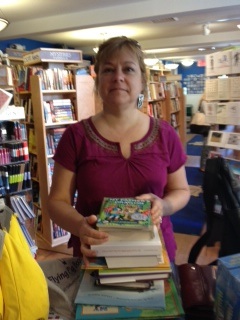One of the perks of owning a bookstore is the myriad school groups that come by the store. If the kids themselves weren’t cute enough, the thank-you cards they send are just so adorable. 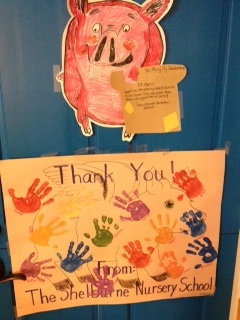
I’ve found that the younger the kid, the cuter the thank you. Obvious teacher input helps keep the chaos down to a minimum. These two are some of my favorites. The hand-drawn flying pig with all the small prints with the student’s names just charms me to bits. I love that this class really took some time to make this. All the kids probably loved a reason to play with paint.
The other note is charming for its obvious kid-drawn pig. I love that someone drew that and then one, or several kids colored it in. The note was a thank you for a visit from Kate DiCamillo and the addition of a piece of toast in honor of Mercy Watson is just delightful.
We often get these thank yous hand-delivered by a teacher. They go immediately onto the office door for all to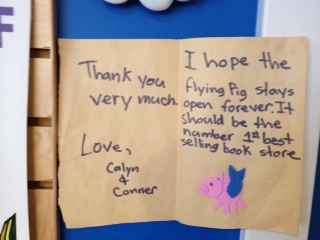 see. Sometimes, kids just write us thank you letters and tell us how much they love the store. What I love about the card on the right is it from Elizabeth’s young cousin, Calyn. She wrote the card when she was eight and now she’s a senior in high school who is one of the most voracious readers I’ve ever known. Now, she sends email thank yous, which are lovely. As are the Facebook updates about the books she’s reading, but nothing will ever be as delightful as the hand-drawn card of a child.
see. Sometimes, kids just write us thank you letters and tell us how much they love the store. What I love about the card on the right is it from Elizabeth’s young cousin, Calyn. She wrote the card when she was eight and now she’s a senior in high school who is one of the most voracious readers I’ve ever known. Now, she sends email thank yous, which are lovely. As are the Facebook updates about the books she’s reading, but nothing will ever be as delightful as the hand-drawn card of a child.
Monthly Archives: August 2012
Your Favorite Book of the Year?
Elizabeth Bluemle - August 30, 2012
If you were going to choose your absolute favorite book of 2012, what would it be? How about your favorite 125, across all ages and genres?
Every November, we create a colorful book review newsletter filled with our favorite releases from the current year. This turns out to be 125 to 150 books, give or take, each reviewed by one of our booksellers, Josie, or me.
I design the catalog, and we’ve used just two different printers for the finished product since 1996, when our newsletter was four pages in one color, and printed on a traditional press. Now it’s sixteen pages, full-color, printed digitally on partially recycled paper with gorgeous soy inks. The end result is something we’re proud of: it looks beautiful, uniquely represents our store and its booksellers, and is filled with treasures. With a mailing list of around 5,000, it’s an expensive piece to print, and we use it all year long as a selling and promotion tool, so you can imagine how carefully we weigh each book that goes into it.
It’s not an easy task to whittle down a year’s worth of titles, fiction and non, to just 125 goodies for all ages, from babies to adults. There’s always the risk of forgetting to include a book one loved passionately in January or April, whose memory has been buried by months of subsequent releases. There’s also the chance that something extraordinary has come out that we just didn’t happen to read. There are difficult decisions that must be made: we can highlight just 8-12 titles for each age group, and that small group will ideally represent a balanced mix of genres (realistic fiction, fantasy, nonfiction, poetry, sports, humor, etc.). This means that if we love five MG friendship stories, we may only be able to choose one or two.
We also like to feature unusual titles, wonderful books by small presses, and midlist titles that deserve a “lead-title” readership, so sometimes a well-known, starred-review book won’t make the newsletter because we know it will still get all the sales it deserves through successful national promotion.
This means that some of our loved titles just won’t make the newsletter. We’ll still handsell them, of course, but the newsletter is prime real estate for our store—and many authors and artists are alert to that. This creates a little added pressure. The children’s book field especially is a small and close one; it can be awkward to run into someone whose book we loved but didn’t put into the newsletter for one of the reasons above. Once, several years ago, I saw a local author at a book conference, and he let me know how hurt he’d been that, the prior year, his book hadn’t been included. We hadn’t even known his book had come out; the publisher didn’t have a sales force in Vermont, and the author hadn’t sent it to us himself, so it wasn’t anywhere on our radar. It was eye-opening and distressing that he’d carried around a sense of rejection and hurt feelings for a whole year about a book we’d never even seen.
The best part of choosing books for Pig-Tales is reading them. We sort through the stacks of ARCs all year long; each staff member keeps an eye out for potential newsletter books. This really ramps up in July, as we round the second half of the year and I start keeping a spreadsheet of titles we’ve all been loving. We comb reviews, compare notes with fellow booksellers, and try not to have too much overlap with the NEIBA and ABC catalogs, which we also offer to customers.
So now is our critical juncture: Flying Pig booksellers have been sending me their lists of books they love and think would be perfect for the newsletter, and Josie and I are compiling our lists.
What would make YOUR newsletter, dear readers? What are your 2012 can’t-miss must-reads? (No fair nominating your own book!)
Informative Picture Books
Josie Leavitt - August 28, 2012
I was reorganizing the picture book spinner yesterday and two books caused me to stop and read. I started reading because the books were compelling, but I kept reading because I was learning so much.
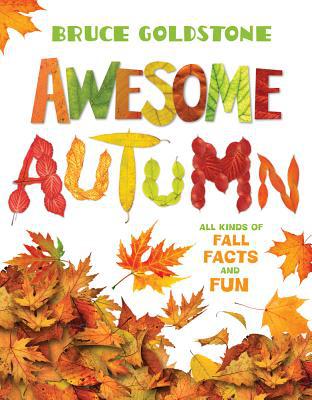 The first book that caught my eye was by Bruce Goldstone. Awesome Autumn: All Kinds of Fall Facts and Fun is chock full of great information. Living in Vermont, I’m always on the lookout for new books that explain the science behind the beauty of fall. The book uses gorgeous photography to show little ones all that happens during autumn.
The first book that caught my eye was by Bruce Goldstone. Awesome Autumn: All Kinds of Fall Facts and Fun is chock full of great information. Living in Vermont, I’m always on the lookout for new books that explain the science behind the beauty of fall. The book uses gorgeous photography to show little ones all that happens during autumn.
It’s not just about leaves turning color and falling to the ground. The book looks at all the changes the season brings. Why do leaves fall off? Why do evergreen trees keep their needles? (The needles are covered with a heavy wax that keeps them from freezing and dying. I didn’t know this.) I really like simple explanations of how some animals migrate south, how some come down from the top of mountains, and others still hibernate. The book touches on all the aspects of fall without being overwhelming for a young child, but full of enough information that an older child, or even an adult, can learn something new. There’s even a great activity page in the back complete with simple instructions.
A Rock Is Lively is the fourth nature-themed book from the dynamic duo of Dianna Hutts Aston 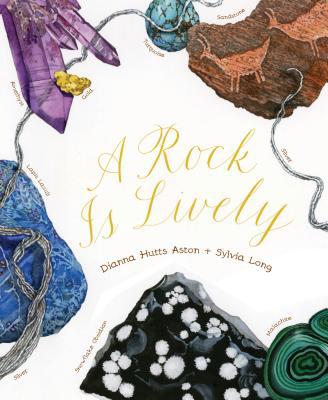 and artist Sylvia Long. This book looks at all manner of rocks. I love the title, because it’s so easy to think of rocks as anything but lively, but in this book, they come alive. Informative paragraphs are accompanied by Sylvia Long’s stunning art. From the title page with the Azurite Geode broken in half to show its depth of color to the last page with thumbnail drawings of every rock in the book, this book thrills with its simplicity and grace.
and artist Sylvia Long. This book looks at all manner of rocks. I love the title, because it’s so easy to think of rocks as anything but lively, but in this book, they come alive. Informative paragraphs are accompanied by Sylvia Long’s stunning art. From the title page with the Azurite Geode broken in half to show its depth of color to the last page with thumbnail drawings of every rock in the book, this book thrills with its simplicity and grace.
I have to admit, I’ve never been a rock collector, but this book makes me want to walk with my head down to see what I can notice. The mix of fonts in this book work really well. Some descriptions are in cursive and others in an easy to read font. Rocks from space are explained in a way that most kids can understand. It was a good refresher for me to see the difference between meteoroids and asteroids (apparently, I’ve been confusing them for years.)
The book works on several levels. The nonfiction readers can read and learn. The children who just think the rocks are beautiful can pore over the detailed drawings. And parents can remind themselves how rocks are used in everyday things. The life cycle of the rock is also stunningly rendered.
This is one of the things about shelving that I love: the spontaneous learning that can happen by just stopping and reading.
PS Here’s what I learned about space rocks: Meteoroids are rocks that range in size from a grain of sand to basketball. They are like a class of rock. When they vaporize as shooting stars they are called meteors, when they hit the earth they’re called meteorites.
Asteroids are giant parts of rock and metal. The book doesn’t say what happens to them when they hit the earth. Probably because they don’t want to terrify the kids about a global killer.
End of Summer Shoppers
Josie Leavitt - August 27, 2012
The end of the summer always brings several kinds of shoppers to the store. The first is the kid who needs to finish summer reading assignments. The second are the moms who are thrilled that the kids are finally heading back to school. And the final end of summer shopper is the college student who was home for the summer and is now returning to school.
We actually had a sign up on our summer reading display that said: lots of books under 200 pages, ask us for recommendations. I do derive a perverse pleasure in seeing the kids come in with a slightly panicked look as they try to find their books for summer reading. Why this amuses me so, I’m not really sure, but I can’t help but laugh a tiny bit. All the kids have the same look when they’re looking at the books: slightly wide-eyed and twitchy.
They are scanning for book length, font size and ease of language. I tried to explain to someone yesterday that she didn’t really have much choice about what to read because there was no time to order books before the weekend. School starts Wednesday, so she was stuck with Brave New World and a version of The Scarlett Letter with the smallest print in the world.
As the summer nears its end, we’ve had a resurgence of women buying books to replace the void left by finishing the Fifty Shades of Grey series. These women love their families, but have found it very difficult to read the other erotica they want with all their kids at home. Now that school in Vermont starts in five days, women have been stocking up. Everyone, it seems, has their list of alternate titles on their phones. They come to the counter, pull up the list and then practically leap for joy when we have all of the titles. One mom put it very bluntly: “It’s time for some me time.” I love helping these women because they are now able to speak about erotica without turning red. They are proudly walking out of the store with their books in their hands, skipping ever so slightly.
The last kind of customer is returning to college. Several of them have stopped on their way back to school. They just need that one last pleasure book. What’s so charming about it is they head right back to the YA section and pick out one of their comforting favorites. They stride up to the counter and hug their book on the way out. I love that.
And finally, there’s a category of end of summer shopper I totally forgot about: the teacher with hundreds of dollars to spend NOW. There can be no ordering. They just need what we have. After six teachers spending hundreds from the end of the day Thursday to Saturday, our middle grade and YA sections are looking fairly spare. I do love the frenetic nature of this kind of shopping. Teachers are just as bad as the kids who are late with their summer reading. I know no one really wants to think about work during the summer, but the sheer number of teachers who have called to make appointments with Elizabeth and me for the weekend is staggering. I fear by today, I’ll have no books left.
I so love the seasonal shifts. Fall is one of my favorite seasons, especially in Vermont. But in the retail world it triggers a little bit of a lull, where we can all catch our breath and gear up for the fourth quarter.
In Praise of Titans
Elizabeth Bluemle - August 23, 2012
This year has taken too many literary lights from us, legends of the children’s book field. I thought 2011 was bad, with the loss of Diana Wynne Jones, Florence Parry Heide, Margaret K. McElderry, and Simms Taback. This year has felt almost apocalyptic. Despite the fact that many of these artists and authors lived rich, full, often very long lives, it is still a shock to lose people who seem immortal to us, whose words and pictures will, indeed, live on forever.
It’s beginning to feel as if an entire generation is leaving us, and I wanted to take this opportunity to celebrate these incredible men and women, so many of whom enriched my own childhood and love of reading.
I’m hoping some creative genius (*cough* oh, Peter Reynolds? *cough*) will put together some kind of celebratory video. Perhaps something that might be played at next year’s BEA Children’s Breakfast, like the Oscars tribute to past icons (but without the awkward applause that grows louder for the better-recognized names).
In the meantime, I just wanted to say one or two things about each one of these children’s literature lights, and invite you all to do the same.
Jose Aruego (August 9, 1932 – August 9, 2012) — His colorful, instantly recognizable, child-appealing art graced such well-loved books as Robert Kraus’s Leo the Late Bloomer and Mitchell Sharmat’s Gregory the Terrible Eater. His artwork pops right off the shelf, bright and happy.
Nina Bawden (January 19, 1925 – August 22, 2012) — Her novel, The Peppermint Pig, won the 1976 Guardian Children’s Fiction Prize; Carrie’s War won the 1993 Phoenix Award and was a commended runner-up for the Carnegie Medal, and in 2010, The Birds on the Trees was a finalist for the Lost Man Booker Prize. As a child, I loved her short mystery adventure novel, The Witch’s Daughter. There was a lonely, somewhat melancholy flavor to the books of hers I read as a young teen that drew me in, provided something resonant and different from the usual fare.
Ray Bradbury (August 22, 1920 – June 5, 2012) — One of the finest science fiction writers long before there was much critical respect for the genre, Bradbury was a fluid, adept writer brilliant at creating setting and suspense, at creating twisted, unforgettable short stories, and limning character in simple, astute strokes. Something Wicked This Way Comes made the hair on the back of my 10-year-old neck stand up; The Martian Chronicles still feels fresh and startling; Fahrenheit 451 is such a classic it almost feels as though it always existed and was simply plucked from the air.
Remy Charlip (January 10, 1929 – August 14, 2012) — Oh, how I loved this man’s creative genius and sense of humor! My sister and I knew every line of text and picture in Arm in Arm; it’s still one of my favorite books to hand to imaginative children. Fortunately is an absolutely perfect picture book for K-3 kids and classrooms. Charlip was involved in so many creative endeavors, including theatre and dance; his legacy is rich.
Leo Dillon (March 2, 1933 – May 26, 2012) — Elegant, striking, dramatic, fine, bold, rich, and deep, Leo and Diane Dillon’s work is distinctive even among the most distinguished art in children’s literature. They are also the only artists to win back-to-back Caldecott Medals. I think of plums, blacks, golds, browns, elongated and dignified figures, contrast that burns images forever in the mind’s eye.
Jean Craighead George (July 2, 1919 – May 15 , 2012) — What kid hasn’t run away to the Catskills and lived in a hollowed-out tree, made a deerskin suit, and trained a falcon courtesy of Newbery Medal-winning author George? My sister and I grew up in the desert, but My Side of the Mountain was a touchstone book for us. Her love and knowledge of nature illuminated all of her books and have connected generations of kids with a natural world many of them might otherwise not have known.
Rosa Guy (September 1, 1922– June 3, 2012) — Coretta Scott King Award winner Guy was a powerful voice for African American writers from the 1950s on. Her 1973 book, The Friends, broke new ground in powerful realistic teen fiction. Her adult novel, My Love, My Love: Or, The Peasant Girl, inspired the Broadway musical, Once on This Island. I discovered Guy’s books as a NYC private school librarian in the early 90s; the eighth graders passionately loved Ruby and The Friends.
Mollie Hunter (June 30, 1922 – July 31, 2012) — Vermont library guru Grace Greene just shared the news of Carnegie Medal winner Mollie Hunter’s passing. Hunter’s novels for children (more than 25) won several distinguished awards, including a 1976 Boston Globe-Horn Book Honor (for A Stranger Came Ashore) and two 1972 New York Times Outstanding Books of the Year (for The Haunted Mountain and A Sound of Chariots). Her Carnegie Medal in 1975 was for the book Grace mentions having particularly loved: The Stronghold. She is a writer I somehow missed, and will look forward to discovering. Thanks, Grace.
Ellen Levine (March 9, 1939 – May 26, 2012) — Ellen was one of my teachers at the Vermont College MFA program. One of the most alive people I’ve ever known, she galvanized students with her passion for telling true stories of ordinary people whose courage triumphed over unspeakable brutality and danger. A lifelong passionate civil rights activist, her nonfiction and fiction tackled everything from the Danish resistance during the Holocaust to the McCarthy era to unplanned teen pregnancies pre-Roe v. Wade.
Thomas Locker (1937 – March 9, 2012) — One of the few artists bringing a lush landscape painting style to children’s literature, Locker illustrated more than 30 books for young people, several of which he also wrote. The timeless Thirteen Moons on Turtle’s Back (written by Joseph Bruchac), Water Dance, and Between Earth and Sky (also by Bruchac) remain Flying Pig perennial favorites.
Margaret Mahy (March 21, 1936 – July 23, 2012) — One of the greatest of the greats, this New Zealand (thank you, alert readers!) legend could write for any age and knock their socks off. Her sense of rhythm and rhyme were unerring; the rumbling, mesmerizing 17 Kings and 42 Elephants is one of the best read-alouds you’ll ever find, as are the comical, riotous Down the Back of the Chair and the Boston Globe-Horn Book Award-winning Bubble Trouble. Her Great Piratical Rumbustification is fantastic middle-grade fun, and her YA fantasy novels are complex and brilliant.
Jean Merrill (January 27, 1923 – August 2, 2012) — A favorite memory from my school librarian days is reading The Pushcart War (published in 1964 and still topical, focusing as it does on small vendors versus giants) to a group of rapt third graders over the course of a few weeks. The Toothpaste Millionaire is also still popular with young readers; Merrill had a magical way of writing with terrific child appeal. I’ve never seen a copy of her The Elephant Who Liked to Smash Small Cars (1967), but I’d really, really like to.
Else Holmelund Minarik (September 13, 1920 – July 12, 2012) — Maurice Sendak’s art was the perfect match for the magic of the Little Bear stories. Minarik’s masterful storytelling created a comforting, cozy, and reassuring world that also had its share of mystery and strangeness. Her books have become part of the fabric of childhood for generations of kids.
Maurice Sendak (June 10, 1928 – May 8, 2012) — Along with the rest of the blogiverse, I wrote about Maurice Sendak’s impact on my life as a young reader immediately after the shock of his passing. His legacy is incalculable; his influence reaches, in some way, every illustrator and author who has come along since he blew the roof off children’s books with his stocky, sturdy little people and their defiant exuberance, his fine lines and bold strokes, his ownership of language, his embrace of the subterranean psychology of childhood and its lingering impact on adulthood, his insistence on seeing and expressing — in his solidly quirky way — what is often softened for children.
Donald Sobol (October 4, 1924 – July 11, 2012) — Encyclopedia Brown! The melted ginger ale ice cubes! Ambergris, the whale vomit! Bugs Meany, that snarling bully, and his thuggish gang of Tigers! And the awesome Sally Kimball, one of the few worthy female co-protagonists found in boy adventure-land at the time. Ah, Donald Sobol, your little chapter-length mysteries confounded me almost every single time, though I cheated and peeked at the solutions in the back while trying unsuccessfully to convince my older sister that I had too known that goose breast is dark meat. I think I did get the ginger ale one, though. Or at least I’ll go to my own grave claiming I did.
**
When I look at these names, I am astonished by their impact on our lives. MILLIONS of children absorbed and were formed and changed by the works of these men and women. Imagine that!
If there’s a great children’s book critique group in the sky, I hope Margaret Wise Brown and Ursula Nordstrom and E.B. White have set the table, welcoming all of these amazing men and women to what would doubtless be a most joyous, humorous, sharp, and generous gathering. And I hope they all save us a seat.
Greetings from the Gift Show
Josie Leavitt - August 22, 2012
I spent the last three days in New York City at the International Gift Show. I combined this trip with seeing old friends and it turned out to be great. I really like the Gift Show. It’s interesting that I went because I’m not the sidelines buyer, but I think have a sense of what we could use for the fourth quarter. I overspent my self-imposed budget, but I fell in love with a few too many unique things.
I’ve never been to the Javits Center for anything other than BookExpo and I must say, I really liked it. The entire convention center was full of gifts and gifty things. I liked that it was spread out. There was never a crush of people like there can be at BookExpo. In fact, there was never an aisle I felt claustrophobic walking down.
The best part of the show was the Handmade Designs. This was on the fourth floor and it was full of mostly Fair Trade items. Sure, a lot of these items were scarves, actually 80% were textiles, but there were goodies to be had. Wool spun by women earning a livable wage in various parts of the world seemed to what I gravitated towards. The wool came in the form of Christmas ornaments, finger puppets, pen toppers and even bird nesting houses. They were all adorable. I resisted my urge to buy all the owls. I made a grievous buying mistake last year with owl ornaments that will likely plague me for years, as co-workers periodically come across them and shriek at their hideousness. The one great thing about being at the show is actually being able to see things up close. Not every catalog photo accurately represents what the item actually looks like. It’s often been my experience with sidelines that it’s best to hold them in your hands before buying them.
The aisles were full of colorful things. And, unlike the book show, where I know what to gloss over because it just doesn’t fit our store, here I had to look at more. Looking at more means making eye contact and that can always led to a longer booth visit than intended. I couldn’t help but find humor in the sexy items booth being right next to the shofars and special knives used at a bris. To their credit, the booth occupants seemed to get along swimmingly.
One thing I noticed was the actual lack of swag and large bags that dominate BEA. Almost no one had a bag from a booth, and there was certainly nothing to be given out. I did hear haggling, though, which is something I’ve never heard at the book show. With books, no one argues about price. They are priced what they are. But here, folks were bargaining and I loved overhearing that. It gave me hope that commerce is alive and well.
I hope when my purchases come in at the beginning of the fourth quarter, I see nothing but things that will sell and not owls that frighten staff.
Sale Success
Josie Leavitt - August 20, 2012
Our massive sale this past Saturday proved to be a wonderful success. Our little village of Shelburne was hopping with shoppers through the entire day. We were helped by an absolutely gorgeous end of summer day that drew more people to town than usual.
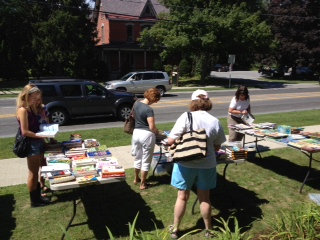 PJ and I got to the store by 8:15 to start setting up. By 8:40 we had folks looking at the books on the outside sales table. The books were loosely arranged by age, with adult books getting
PJ and I got to the store by 8:15 to start setting up. By 8:40 we had folks looking at the books on the outside sales table. The books were loosely arranged by age, with adult books getting
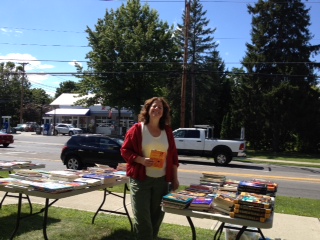 two tables and middle grade and YA sharing a table and then picture books on the end. We thought our set-up was pretty good until Elizabeth got her hands on the books. She has this way of seeing a stack of books almost exactly like a customer would (it’s funny how hard that can be to do sometimes) and rearranged accordingly. Our sales went up every time she tidied. It happened so often that I just had to laugh.
two tables and middle grade and YA sharing a table and then picture books on the end. We thought our set-up was pretty good until Elizabeth got her hands on the books. She has this way of seeing a stack of books almost exactly like a customer would (it’s funny how hard that can be to do sometimes) and rearranged accordingly. Our sales went up every time she tidied. It happened so often that I just had to laugh.Darrilyn, our returns manager, came over early to help set up and stayed for hours. I kept trying to send her home on the gorgeous day, but she was totally engrossed in replenishing the tables and excited about watching the books get sold. It was a fun day for everyone. Shoppers loved it. They couldn’t believe how low some of the prices were and bought armfulls of books. People were remembering cousins for the holidays, buying ahead for a baby shower six months away, and kids were just happy to get a hardcover.
The day was also proof that it takes a village to run a business. Our third scanner broke earlier in the week. While living in Vermont is lovely, it can mean that I don’t always have access to things like bar code scanners in my local stores. All the scanners had to be mail-ordered and I didn’t have time. On a whim, I called the Shelburne Country Store to see if they had a scanner I could borrow. They did! and I was able to sell books outside. We also needed an extension cord with a three-pronged plug. This was discovered at 8:30 in the morning. I wen to the new bakery next door and asked if they had one, and lo and behold, they did! I was so thrilled to save the expense of buying a new cord (I had forgotten mine in the garage) and the time it would take to run that errand.
This sale was fun. People were thrilled to be saving big money and we were thrilled to see so many new faces come in the door. Here’s hoping we see them again during the holidays; I’m sure folks forgot people on their holiday lists.
“Ahhh, I miss the little bookstores….”
Elizabeth Bluemle - August 17, 2012
I have a friend, Guus, who grew up in the Netherlands. We were chatting online about books recently, and he began reminiscing about a favorite bookstore haunt from his childhood. I loved what he said so much I had to share it with you ShelfTalker readers.
“Ahh,” Guus wrote, “I miss the little bookstores from when I was young. There used to be a little secondhand bookstore in the town where I grew up. I met the owner – a lady of roughly 30 years old – on a day I snuck out of school and spent the next six hours reading a rather old book holding the – actual – versions of some fairy tales. Bloody stuff!
“A bookstore with noneuclidian shelves, little nooks with reading chairs…. The owner and I made our acquaintance when I came to realise she’d simply put down a li’l plate of gingersnaps and a glass of milk down by me and went back to her desk. -That- made me decide to go and have a talk with her.
“Heh. She let a ten year old boy have cookies and milk over a book worth a couple of K. I was impressed. and HORRIFIED when I found out. But [she said] – ‘Books are written to be loved. And you were so into that one.’ She became one of my best friends. And I suspect she’s single-handedly responsible for my love of reading.”
I’ve heard these kinds of stories so often over the years. I think often we booksellers have no idea how strongly the very existence of our stores, the simple act of providing a welcoming place for children and books, might affect a young person. Anecdotes like Guus’s are so heartening (and they make me wish we kept gingersnaps and milk on hand!). Before I opened a bookstore, I used to dream of having a home in the country, and a bright library of books available to the neighborhood families, with pitchers of lemonade and window seats for curling up in. The Flying Pig isn’t such a far cry from that dream, and I hope the kids in all of our nearby neighborhoods feel cozy and at home at our store, like Guus did in his.
Did you have a special little bookstore in your childhood? If so, what was your favorite memory of being there?
Getting Ready for a Big Sale
Josie Leavitt - August 16, 2012
Sales are usually thought of as fun at a bookstore. Customers are eager to snap up whatever bargains they might find. And stores are usually happy to get a bump in cash flow, as well as clearing out the inventory. In our town we have an annual Shelburne Town Day in August, which is when all the retail shops have massive sales. This strategy is a great way to keep visitors in town all day browsing the deals at every store.
Getting ready for a big sale can be an enormous undertaking. Our sale is this Saturday and we are going to put a lot on deep discount. As rules for publisher returns get tighter and tighter, we have found ourselves with books we no longer want, but need to get rid of. Books that have missed their return window are now out of print. We are trying something new: having sales tables filled with deeply discounted books on the front lawn of the store. Often our sales can get convoluted with different discounts for just about every section.
The pricing for this sale is quite simple: 25% off everything inside the store, and outside the store we’ll be selling paperbacks for $2 and hardcovers for $5. We’ll even be ready to process sales outside so folks who are really bargain-hunting can get rung up on the porch. As much as I know we have to sell these books, it still pains me to see some of them go. The thing about sales like this that’s so humbling is I am confronted with my poor buying decisions and bad habits. Nothing makes me feel worse than seeing a stack of picture books I thought were great, but just couldn’t sell and now can’t return.
Setting up all the books is a challenge and one I seldom leave enough time for. First we have to identify the books that are going on deep discount. Here I am blessed by Darrilyn who is in charge of all our returns now. She knows exactly what is out of print and has labeled everything clearly in the basement. Next, we bring up the books and put either a red or blue dot on them. Red dot books are $2 and blue dot books are $5. This process, while tedious, can stave off confusion at the register inside the store when steeply discounted books get mixed in with in-store inventory.
The last, and probably the most important part of a sale, is making everything look good. Sales where the merchandise looks scattered and haphazard. This is where Elizabeth saves the day. She just has a knack for making a stack of books look good and inviting. She makes sure the sale tables stay full and yummy looking right till the end of the sale. These sale days can be exhausting.
There is triumph in a sale, too. To see some truly wonderful books finally find good homes is a lovely thing to see. The look on a kid’s face when he realizes that he can actually get all the books he wants. The briskness of a sale day is also a lot of fun. The feeling of ringing up sales almost as fast as during the holiday season is exhilarating.
And the best, part of the sale this year? There’s now a bakery with coffee next door. So, we don’t have to travel for our sustaining sugar and caffeine.
When Kids Give Tours of the Store
Josie Leavitt - August 15, 2012
There is a lovely occurrence every summer at our store. Visiting friends get a personal tour of the store. What makes this especially lovely is when the tour guides are children.
Yesterday, Emma, a girl of about eight or so, led a very thorough tour of the store for her visiting cousins. Each section was described in great detail. The board book section was described in these terms: “I used to get from this part, but now I go here.” She led her younger cousins to the middle grade section where all the kids camped out for a little while. When they were getting ready to get rung up, Emma told the kids that “they have the best toys.” The family then proceeded to play with the noisy toys, having an absolute ball. Young Emma also encouraged her youngest cousin to check out the vacuum in the bathroom. Apparently, cleaning supplies in the bathroom are fun for kids to see.
What I love about kids showing off the store is their absolute sense of pride in us. Sometimes I forget that kids feel very strongly about the store. They may not always express this the way their parents do, by actually telling us – they just run to the sections that make them happy. Ownership in the store starts young. Little kids saying things like “This is where I got my favorite book” make me inordinately pleased. Sometimes, all I need at the end of a long day is a kid who walks proudly through the store exclaiming the whole time.

